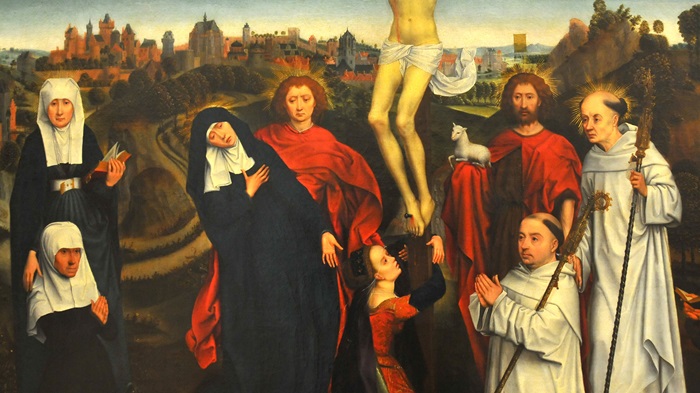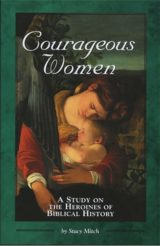By Stacy Mitch
Stacy Mitch is the author of the successful Courageous Women Bible study series.

“Throughout the Old Covenant the mission of many holy women prepared for that of Mary. . . . Mary ‘stands out among the poor and humble of the Lord, who confidently hope for and receive salvation from him. After a long period of waiting the times are fulfilled in her, the exalted Daughter of Sion, and the new plan of salvation is established’” (CCC 489).
In the fullness of time, God sent His Son. In the fullness of time, God chose to bless a poor girl of Nazareth, making her both the Mother of God and the Queen of Heaven and Earth. While all the women of salvation history have exemplified various virtues and performed heroic actions, it is Mary, the Mother of Jesus, who, through the fullness of God’s grace, encompasses and exemplifies all virtues—both natural and supernatural—to the greatest degree. God preserved her from all stain of original sin, and she stands tall, on the fullness of God’s grace, as a beacon of faith, hope, and love (CCC 491). Through His grace we are made her children, and she is a faithful Mother perpetually leading us to her Son.
As the Catechism, quoting Saint Irenaeus, Epiphanius, and Saint Jerome, teaches, “‘Being obedient she became the cause of salvation for herself and for the whole human race.’ Hence not a few of the early Fathers gladly assert . . . : ‘The knot of Eve’s disobedience was untied by Mary’s obedience: what the virgin Eve bound through her disbelief, Mary loosened by her faith.’ Comparing her with Eve, they call Mary ‘the Mother of the living’ and frequently claim: ‘Death through Eve, life through Mary’” (CCC 494)
Mary responded to the call to be the Mother of God by saying, “Behold, I am the handmaid of the Lord; let it be to me according to your word” (Luke 1:38). Mary could have made excuses (as Moses did) and declared she was not up to the task, or she could have shown a lack of faith in the power of God to accomplish the seemingly impossible (as Zechariah did). Instead, she who was full of grace accepted the mission of God as the handmaid of Him Who made and sustained her.
Mary, who nursed Jesus as a baby, taught Him to put His dirty clothes in the laundry basket as a child, and watched Him minister to thousands as an adult, stood at the foot of the Cross as He was crucified. As Simeon had prophesied, a sword did indeed pierce her soul (Luke 2:35). From the Cross, He addressed her, “Woman, behold, your son!” (John 19:26). And to John, the Beloved Disciple, the only apostle at the Cross, He said, “Behold, your mother!” (John 19:27). John cared for Mary from this point forward. The Church understands this to be the point at which Jesus made Mary the Mother of the children of the Church.
There she stood, in keeping with the divine plan, enduring with her only begotten Son the intensity of his suffering, joining herself with his sacrifice in her mother’s heart, and lovingly consenting to the immolation of this victim, born of her: to be given, by the same Christ Jesus dying on the cross, as a mother to his disciple, with these words: “Woman, behold your son” (CCC 964).
The life of Mary exemplifies every Christian virtue and is encompassed in one of the most difficult of acts to which we are all called: service. Mary’s life was entirely about serving God by caring for Jesus, caring for her family, caring for her neighbors, and caring for the infant Church. In Heaven, she still intercedes for her millions of children on earth. In Mary, we are truly taught the meaning of “to serve is to reign” (CCC 786).
You Might Also Like

Stacy Mitch’s Courageous Women is designed to encourage and edify women through the examples of women in Sacred Scripture. Emphasizing the virtues they personify, this study helps women cultivate heroic virtue in their own lives.

